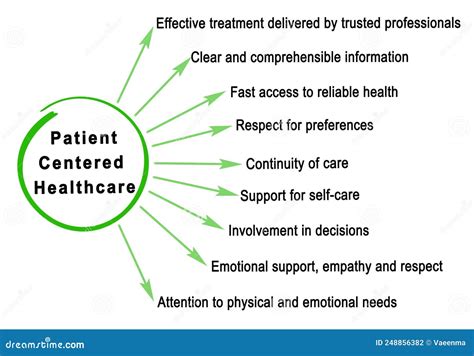Intro
Improve your healthcare experience with a Patient Care Partnership. Learn how to take an active role in your care, communicate effectively with healthcare providers, and make informed decisions. Discover the benefits of a collaborative approach to healthcare, including better health outcomes, increased patient satisfaction, and improved quality of life.
The relationship between healthcare providers and patients is a crucial aspect of the healthcare system. A positive and collaborative partnership can lead to better health outcomes, improved patient satisfaction, and more efficient care. In recent years, there has been a growing emphasis on patient-centered care, which prioritizes the needs and preferences of patients in the decision-making process. This approach is often referred to as the Patient Care Partnership.
A Patient Care Partnership is a collaborative relationship between healthcare providers, patients, and their families. It is built on mutual respect, trust, and open communication. The partnership aims to empower patients to take an active role in their care, making informed decisions about their health and well-being. By working together, healthcare providers and patients can achieve better health outcomes, reduce medical errors, and improve the overall quality of care.
Benefits of a Patient Care Partnership
A Patient Care Partnership offers numerous benefits to both patients and healthcare providers. Some of the most significant advantages include:
- Improved health outcomes: By involving patients in the decision-making process, healthcare providers can tailor care to meet individual needs and preferences, leading to better health outcomes.
- Increased patient satisfaction: Patients who feel empowered and involved in their care are more likely to be satisfied with their healthcare experience.
- Reduced medical errors: Open communication and collaboration can help reduce medical errors, as patients and healthcare providers work together to identify potential safety concerns.
- Enhanced patient engagement: A Patient Care Partnership encourages patients to take an active role in their care, leading to increased engagement and motivation to manage their health.
- Better care coordination: Collaboration between healthcare providers and patients can help ensure that care is well-coordinated, reducing fragmentation and improving overall quality.

Key Principles of a Patient Care Partnership
A Patient Care Partnership is built on several key principles, including:
- Respect: Healthcare providers and patients must respect each other's values, preferences, and needs.
- Trust: Trust is essential in a Patient Care Partnership, as patients must feel confident in their healthcare providers' abilities and intentions.
- Open communication: Clear and open communication is critical, as patients and healthcare providers must be able to share information and concerns effectively.
- Collaboration: Healthcare providers and patients must work together to make informed decisions about care.
- Empowerment: Patients must be empowered to take an active role in their care, making informed decisions about their health and well-being.
Effective Communication in a Patient Care Partnership
Effective communication is critical in a Patient Care Partnership. Healthcare providers must be able to communicate clearly and effectively with patients, taking into account individual needs and preferences. Some strategies for effective communication include:
- Using plain language: Avoid using technical jargon or complex medical terminology that patients may not understand.
- Active listening: Healthcare providers must listen carefully to patients' concerns and questions, responding thoughtfully and empathetically.
- Non-verbal communication: Non-verbal cues, such as body language and tone of voice, can convey important information and build trust.
- Patient education: Healthcare providers must educate patients about their condition, treatment options, and self-care strategies.
Implementing a Patient Care Partnership in Practice
Implementing a Patient Care Partnership in practice requires a commitment to patient-centered care and a willingness to adapt to individual needs and preferences. Some strategies for implementing a Patient Care Partnership include:
- Patient and family advisory councils: Establishing patient and family advisory councils can help healthcare providers understand patient needs and preferences.
- Patient engagement strategies: Implementing patient engagement strategies, such as patient portals and mobile apps, can help patients take an active role in their care.
- Care coordination: Coordinating care across healthcare settings and providers can help ensure that patients receive seamless, high-quality care.
- Staff training: Providing staff training on patient-centered care and communication can help healthcare providers build strong relationships with patients.

Challenges and Barriers to a Patient Care Partnership
While a Patient Care Partnership offers numerous benefits, there are also challenges and barriers to implementation. Some common challenges include:
- Time constraints: Healthcare providers may feel pressured to see patients quickly, leaving limited time for communication and collaboration.
- Language barriers: Language barriers can create communication challenges, particularly in diverse patient populations.
- Cultural differences: Cultural differences can impact patient preferences and values, requiring healthcare providers to be sensitive to individual needs.
- Technological barriers: Technological barriers, such as limited access to patient portals or mobile apps, can hinder patient engagement and communication.
Overcoming Challenges and Barriers
To overcome challenges and barriers to a Patient Care Partnership, healthcare providers can implement strategies such as:
- Cultural competency training: Providing cultural competency training can help healthcare providers understand and respond to individual patient needs.
- Language access services: Offering language access services, such as interpreters or translation services, can help overcome language barriers.
- Patient education: Educating patients about their condition, treatment options, and self-care strategies can help empower them to take an active role in their care.
- Technology solutions: Implementing technology solutions, such as patient portals and mobile apps, can help facilitate communication and patient engagement.
Conclusion
A Patient Care Partnership is a collaborative relationship between healthcare providers, patients, and their families. By prioritizing patient-centered care and open communication, healthcare providers can empower patients to take an active role in their care, leading to better health outcomes, increased patient satisfaction, and improved quality of care. While there are challenges and barriers to implementation, healthcare providers can overcome these by implementing strategies such as cultural competency training, language access services, patient education, and technology solutions.

We invite you to share your thoughts and experiences with a Patient Care Partnership. How have you seen this approach benefit patients and healthcare providers? What challenges have you encountered, and how have you overcome them? Share your comments and insights below.
What is a Patient Care Partnership?
+A Patient Care Partnership is a collaborative relationship between healthcare providers, patients, and their families. It prioritizes patient-centered care and open communication to empower patients to take an active role in their care.
What are the benefits of a Patient Care Partnership?
+The benefits of a Patient Care Partnership include improved health outcomes, increased patient satisfaction, reduced medical errors, enhanced patient engagement, and better care coordination.
What are the key principles of a Patient Care Partnership?
+The key principles of a Patient Care Partnership include respect, trust, open communication, collaboration, and empowerment.
